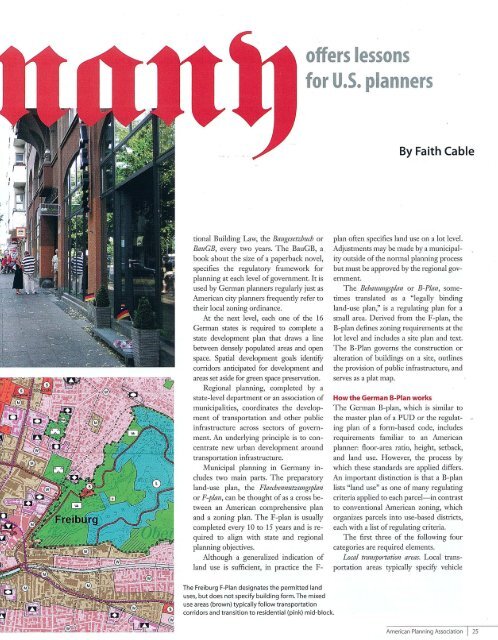Design First, Codify Second: Germany Offers Lessons for
Design First, Codify Second: Germany Offers Lessons for
Design First, Codify Second: Germany Offers Lessons for
You also want an ePaper? Increase the reach of your titles
YUMPU automatically turns print PDFs into web optimized ePapers that Google loves.
tional Building Law, the Baugesetzbucb or<br />
BauGB, every two years. The BauGB, a<br />
book about the size of a paperback novel,<br />
specifies the regulatOlY framework <strong>for</strong><br />
planning at each level of govermnent. It is<br />
used by German plalmers regularly just as<br />
American city planners frequently refer to<br />
tlleir local zoning ordinance.<br />
At the next level, each one of tlle 16<br />
German states is required to complete a<br />
state development plan mat draws a line<br />
between densely populated areas and open<br />
space. Spatial development goals identify<br />
corridors anticipated <strong>for</strong> developlnent and<br />
areas set aside <strong>for</strong> green space preservation.<br />
Regional planning, completed by a<br />
state-level deparunent or an association of<br />
municipalities, coordinates tlle development<br />
of u'ansportation and otller public<br />
infi:asu'ucture across sectors of government.<br />
An underlying principle is to concentrate<br />
new urban development arOlUld<br />
u'ansportation infi:asu·ucture.<br />
Municipal planning in <strong>Germany</strong> includes<br />
two main parts. The preparatory<br />
land-use plan, me Flaecbennutzzmgsplan<br />
or F-plan, can be tllought of as a cross between<br />
an American comprehensive plan<br />
and a zoning plan. The F -plan is usually<br />
completed evelY 10 to 15 years and is required<br />
to align wim state and regional<br />
planning objectives.<br />
Altllough a generalized indication of<br />
land use is sufficient, in practice tlle F-<br />
The Freiburg F-Plan designates the permitted land<br />
uses, but does not specify building <strong>for</strong>m. The mixed<br />
use areas (brown) typically follow transportation<br />
corridors and t ransition to res idential (pink) mid-block.<br />
offers lessons<br />
<strong>for</strong> u.s. planners<br />
By Faith Cable<br />
plan often specifies land use on a lot level.<br />
Adjusunents may be made by a municipality<br />
outside of tlle normal planning process<br />
but must be approved by the regional government.<br />
The BebflZumgsplan or B-Plmz, sometimes<br />
u'anslated as a "legally binding<br />
land-use plan," is a regulating plan <strong>for</strong> a<br />
small area. Derived from tlle F-plan, me<br />
B-plan defines zoning requirements at me<br />
lot level and includes a site plan and text.<br />
The B-Plan governs tlle consUlICtion or<br />
alteration of buildings on a site, outlines<br />
the provision of public infrasUl.lcture, and<br />
serves as a plat map.<br />
How the German B-Plan works<br />
The German B-plan, which is similar to<br />
me master plan of a PUD or tlle regulating<br />
plan of a <strong>for</strong>m-based code, includes<br />
requirements familiar to an American<br />
planner: floor-area ratio, height, setback,<br />
and land use. However, the process by<br />
which tllese standards are applied differs.<br />
An important distinction is tllat a B-plan<br />
lists "land use" as one of many regulating<br />
criteria applied to each parcel- in contrast<br />
to conventional American zoning, which<br />
organizes parcels into use-based disu'icts,<br />
each witll a list of regulating criteria.<br />
The first mree of me following four<br />
categories are required elements.<br />
Local transportation areas. Local u'ansportation<br />
areas typically specify vehicle<br />
Ameri ca n Planning Association 25


